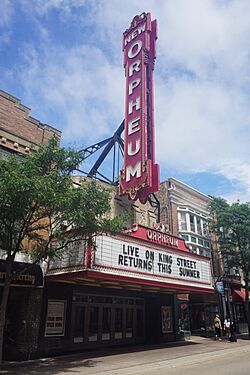Orpheum Theatre (Madison, Wisconsin) facts for kids

Marquee of the theatre, viewed from State Street
|
|
| Address | 216 State St Madison, WI 53703-2215 |
|---|---|
| Owner | Gus Paras |
| Operator | Live Nation |
| Capacity | 1,727 |
| Construction | |
| Opened | March 21, 1927 |
| Construction cost | $750,000 ($12.5 million in 2022 dollars ) |
| Architect | Rapp & Rapp |
| Website | |
|
Orpheum Theatre
|
|
| Architectural style | Beaux-Arts |
| NRHP reference No. | 07001460 |
| Added to NRHP | January 23, 2008 |
The Orpheum Theatre is a famous place in downtown Madison, Wisconsin, where people can watch live shows and concerts. It was built in the 1920s as a special kind of movie theater called a 'movie palace.' It's located very close to the Wisconsin State Capitol building. In 2008, the Orpheum was added to the National Register of Historic Places. This means it's an important historical building, known as the best example of a movie palace still standing in Madison.
Contents
A Look Back: The Orpheum's History
Before the 1900s, a "theater" was usually a place to see live shows. These included vaudeville (a mix of acts like comedy, music, and dance), opera, or live music. An example in Madison was the Fuller Opera House, built in 1890.
The Rise of Moving Pictures
Around 1900, something new arrived: motion pictures, or movies! At first, movies were shown in simple places like stores. These early movie spots were often called "nickelodeons" because a ticket cost only five cents. The Fuller Opera House started showing movies, and new theaters like the Majestic (1906) and the Amuse (1910) were built. In 1909, the Grand Theater was built just for movies. Movies quickly became very popular. By 1913, Madison had eight theaters showing only movies. About one-tenth of the city's population went to a movie every day!
The Era of Movie Palaces
Once movies were a big hit, some theaters became extra fancy. These were called "movie palaces." They were much larger and had amazing, detailed interiors. These grand designs were meant to make people feel like they were in exotic places. Imagine walking into a theater that looked like ancient Egypt or a royal palace! The Orpheum in Madison is one of these special movie palaces, and it's still mostly the same as it was when it opened.
Designing the Orpheum Theatre
The Orpheum was designed in 1925 by C.W. and George L. Rapp from Chicago. They were among the best theater designers in the United States at that time. They created a beautiful outside made of limestone in the Art Deco style. A tall, glowing sign saying "NEW ORPHEUM" became a famous sight on State Street.
Inside, the ticket lobby still has its original terrazzo floors. Beyond that is the Grand Lobby, which is two stories tall. It has a snack bar and two beautiful terrazzo staircases with bronze railings. This area is decorated in a French Renaissance style, with fancy decorations like swags, wall sconces, and chandeliers. There's even a marble statue called "The Young Shepherd." The stairs lead to more hallways that curve around the main show area. The fancy style, inspired by King Louis XIV's palaces in France, continues throughout the entire theater. The main auditorium was built to hold 2,500 people.
Opening Day and Early Years
The Orpheum cost $750,000 to build. A dentist named William Beecroft, known as "Mr. Theater," helped pay for it. A lot of care was put into making sure visitors were comfortable. It had a modern climate control system, advanced lighting, and special lounges for ladies and gentlemen.
The Orpheum opened on March 31, 1927. The first show included a newsreel, a silent film called Nobody's Widow (with live organ music), and vaudeville acts. This show started at 1 PM and was repeated three times, ending at 11 PM. More than 7,000 people came that day, and many others waited in long lines!
Other Madison Movie Palaces
Madison had other movie palaces too. In 1917, the Amuse Theater became the Strand Theater. It was also designed by Rapp and Rapp. A year after the Orpheum opened, the Capitol Theater opened right across the street. It was another movie palace, also designed by Rapp and Rapp. Parts of the old Capitol Theater are now inside the Overture Center. Later, the Eastwood Theater opened in 1929. It was also a movie palace, but less fancy than the Orpheum. Today, it's known as the Barrymore Theater.
Changes Over Time
Going to the movies was most popular around 1946. After that, fewer people went. People became more interested in movie stars than in the fancy theaters themselves. In the 1950s and 60s, television became popular, offering free entertainment at home. Also, as people moved to the suburbs, new theaters were built there. This meant fewer customers for downtown theaters like the Orpheum. Over the years, the Orpheum has changed. It now hosts live artists and events like weddings.
Cool Facts About the Orpheum
- The Orpheum Theatre was the very first building in Wisconsin to have air conditioning! The air conditioner itself was so big it took up an entire room in the basement.
- When it first opened, the Orpheum Theatre could seat 2,400 people. After some changes in the 1960s, about 700 seats were removed. Now, it can hold around 1,700 people.
- The Orpheum nearly burned down on December 19, 2004, due to a fire.
See also
- House Of Blues



